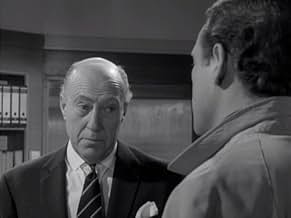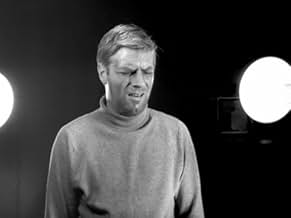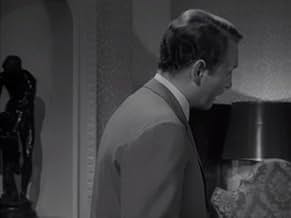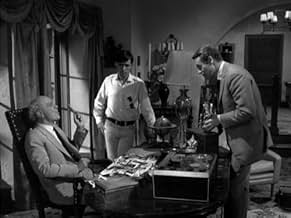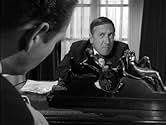IMDb RATING
8.2/10
1.7K
YOUR RATING
John Drake is a special operative for M9, specializing in security assignments against any subversive element that threatens world peace.John Drake is a special operative for M9, specializing in security assignments against any subversive element that threatens world peace.John Drake is a special operative for M9, specializing in security assignments against any subversive element that threatens world peace.
Browse episodes
Featured reviews
Secret Agent Man
Known in the States as Secret Agent Man, Danger Man with just a few misfire episodes, is for me, the best television in history. Better at what it does than what Seinfeld did for its genre, better even, than the BBC's The Office. 'The Best.' The stonking, pound-for-pound champion of television. Better still, than its successor, The Prisoner.
Despite what has dated, what is stunning about Danger Man is what has not. In a sense, it's sickeningly depressing, because the plot concerns are eerily of the moment. Right wing takeovers, identity theft, internment camps, Geneva and Rome endings for unlucky agents and a majority of episodes concerning the Middle East, which- either through huge coincidence or prescience, relate to Iraq, Israel and Lebanon! There is even a slightly anti-Israeli cautionary tale how likely is that, today or any day? (No turncoat is John Drake; there is a touching episode or three when Drake doesn't cut any slack to those who have sold out their country, whatever their sad stories.)
Despite rumors, Patrick McGoohan was apparently never in British Intelligence. A little boxing, stage acting and chicken farming, yes; spying, no. McGoohan certainly fits the perception of the professional spy: Incredibly handsome, tall, and tough but separate that image - also, humane, free of racial prejudiced and pro-women. Drake uses brain and brawn- he throws a good right hander, for example, though his pathetically slow running, is thankfully, kept to a minimum. (For a real laugh, dig Sean Connery running in You Only Live Twice. These spy cats ain't sprinters.)
As has been noted countless times, it's rather remarkable, that the program's standard of writing in an average episode, as high as a good film - was maintained, week in, week out. Rare duff episodes aside, Danger Man is that rare show with consistently great and novel writing. Many episodes demand repeated viewing.
The Danger man formula included fine photography. There are exotic exteriors McGoohan who incidentally, co-wrote several of the better episodes, let his camera people fly around the world and film whatever they liked. The interiors were filmed - I believe at Shepperton and with a few conspicuous exceptions, (some 'beaches' set in the Caribbean are dire) the interiors are HIGHLY convincing. Thus, the exterior shots of the Alps are followed by cuts to Switzerland- at- Shepperton, if you will; just marvelous; though the lighting of course, never matched.
In most episodes, Drake meets his masters for assignments in a variety of London locales. Brilliant. Are our own security services this smart? The wonderful harpsichord tune, an inevitable shot of a jet plane landing God knows where and we know: 'Here comes Drake, the brainy detective to once again, prevail with his wits with a little help from dem fists!'
The foresight is creepy. McGoohan, who must be a peacenik, seems, from almost 40 years ago, to warn us across the chasm of time, of the dangers of a society under constant surveillance, plagued by right-wing lunatics, both harassed and sold out. A society with an uncertain future. Using his masterful Shakespearian voice (he was voted tops on the stage in 60') a fairly good range and some specialties drunks are particularly good; McGoohan and company are very formulaic per 1960's norm but what a wonderful brew they've concocted.
The guest stars are, almost without exception, excellent and diverse. So good that when a well-known British character actor is doing the world's worst Scottish accent; somehow, the plot flows on. The terrible attempts at a burr are in fact, an unadvertised, campy bonus. Surprises abound from a talented cast of stars in many cases, easily eclipsing the performances of name actors from the big screen.
In the final analysis, it is Drake, Pat McGoohan and the writers, himself included, which make this the best show in the short history of TV. Patriot and lover of Britain to the end, handy man with gadgets, hater of guns and promiscuous sex, these are part of the appeal. But it is the palpable sense of doubled standards worrying Drake that is the real star shower: 'How bad is the East,' and, 'Does the murder' (yes, murder) 'that our side gets up to is it justified in a war on, among other things, terror and is the price sustainable?'
The best episode is a pure fantasy rather than a espionage or political thriller. It is a tale of identity theft involving perfect plastic surgery impossible in 1964, yet today's news. That episode, 'Slay It With Flowers,' with its dazzling guest stars foremost, young Rachel Herbert with a stellar turn as the innkeeper's daughter, is probably the best that television will ever be A plot torn from today's headlines fine acting, palpable danger, and above all John Drake's creed that people who don't deserve to get hurt, do.
But not if he can help it. And help he does.
Dangerman is here!
** If you can find the last two episodes in color, you're in for a treat. While most reviewers find them stilted, (McGoohan lost interest after filming the episodes and immediately ended the series) I beg to differ. The color is great and one scene, set amongst Kabuki 'dolls' one of which is a very real, murderous human, is one of the finest things I've ever seen attempted.
Known in the States as Secret Agent Man, Danger Man with just a few misfire episodes, is for me, the best television in history. Better at what it does than what Seinfeld did for its genre, better even, than the BBC's The Office. 'The Best.' The stonking, pound-for-pound champion of television. Better still, than its successor, The Prisoner.
Despite what has dated, what is stunning about Danger Man is what has not. In a sense, it's sickeningly depressing, because the plot concerns are eerily of the moment. Right wing takeovers, identity theft, internment camps, Geneva and Rome endings for unlucky agents and a majority of episodes concerning the Middle East, which- either through huge coincidence or prescience, relate to Iraq, Israel and Lebanon! There is even a slightly anti-Israeli cautionary tale how likely is that, today or any day? (No turncoat is John Drake; there is a touching episode or three when Drake doesn't cut any slack to those who have sold out their country, whatever their sad stories.)
Despite rumors, Patrick McGoohan was apparently never in British Intelligence. A little boxing, stage acting and chicken farming, yes; spying, no. McGoohan certainly fits the perception of the professional spy: Incredibly handsome, tall, and tough but separate that image - also, humane, free of racial prejudiced and pro-women. Drake uses brain and brawn- he throws a good right hander, for example, though his pathetically slow running, is thankfully, kept to a minimum. (For a real laugh, dig Sean Connery running in You Only Live Twice. These spy cats ain't sprinters.)
As has been noted countless times, it's rather remarkable, that the program's standard of writing in an average episode, as high as a good film - was maintained, week in, week out. Rare duff episodes aside, Danger Man is that rare show with consistently great and novel writing. Many episodes demand repeated viewing.
The Danger man formula included fine photography. There are exotic exteriors McGoohan who incidentally, co-wrote several of the better episodes, let his camera people fly around the world and film whatever they liked. The interiors were filmed - I believe at Shepperton and with a few conspicuous exceptions, (some 'beaches' set in the Caribbean are dire) the interiors are HIGHLY convincing. Thus, the exterior shots of the Alps are followed by cuts to Switzerland- at- Shepperton, if you will; just marvelous; though the lighting of course, never matched.
In most episodes, Drake meets his masters for assignments in a variety of London locales. Brilliant. Are our own security services this smart? The wonderful harpsichord tune, an inevitable shot of a jet plane landing God knows where and we know: 'Here comes Drake, the brainy detective to once again, prevail with his wits with a little help from dem fists!'
The foresight is creepy. McGoohan, who must be a peacenik, seems, from almost 40 years ago, to warn us across the chasm of time, of the dangers of a society under constant surveillance, plagued by right-wing lunatics, both harassed and sold out. A society with an uncertain future. Using his masterful Shakespearian voice (he was voted tops on the stage in 60') a fairly good range and some specialties drunks are particularly good; McGoohan and company are very formulaic per 1960's norm but what a wonderful brew they've concocted.
The guest stars are, almost without exception, excellent and diverse. So good that when a well-known British character actor is doing the world's worst Scottish accent; somehow, the plot flows on. The terrible attempts at a burr are in fact, an unadvertised, campy bonus. Surprises abound from a talented cast of stars in many cases, easily eclipsing the performances of name actors from the big screen.
In the final analysis, it is Drake, Pat McGoohan and the writers, himself included, which make this the best show in the short history of TV. Patriot and lover of Britain to the end, handy man with gadgets, hater of guns and promiscuous sex, these are part of the appeal. But it is the palpable sense of doubled standards worrying Drake that is the real star shower: 'How bad is the East,' and, 'Does the murder' (yes, murder) 'that our side gets up to is it justified in a war on, among other things, terror and is the price sustainable?'
The best episode is a pure fantasy rather than a espionage or political thriller. It is a tale of identity theft involving perfect plastic surgery impossible in 1964, yet today's news. That episode, 'Slay It With Flowers,' with its dazzling guest stars foremost, young Rachel Herbert with a stellar turn as the innkeeper's daughter, is probably the best that television will ever be A plot torn from today's headlines fine acting, palpable danger, and above all John Drake's creed that people who don't deserve to get hurt, do.
But not if he can help it. And help he does.
Dangerman is here!
** If you can find the last two episodes in color, you're in for a treat. While most reviewers find them stilted, (McGoohan lost interest after filming the episodes and immediately ended the series) I beg to differ. The color is great and one scene, set amongst Kabuki 'dolls' one of which is a very real, murderous human, is one of the finest things I've ever seen attempted.
This spy drama was in the mold of the first '007' movie, "DR. No". A crossover from the paranoid deep cover spy of the 50's to the gadget and spoof of the 60's. And to top it off, Patrick McGoohan, as the secret agent, was terrific. Cool, low keyed, sharp as a tack, traveling to different ports of call. Plots were generally good. Unfortunately, due to its mature nature and age, chances of it being televised grows less year by year...Alas poor Yorick. If you do gain access to these episodes, go for it. You won't be disappointed.
This show never laughs at itself (setting it apart from most of the James Bond and follow-on genre shows). Instead, it projects the inimitable Patrick McGoohan as a consistently efficacious hero: fast-thinking, innovative, ultra-capable, tenaciously-focused on the mission, yet when achieving the mission is not enough, he's able to think outside the box, to re-define his goals and achieve success in a wider context.
For a little boy starving to see a hero on television, "Danger Man" (and the subsequent "Secret Agent Man") was just what I needed. A hundred times over the years, facing my own moments of challenge, I remembered how John Drake had handled things. Nevermind the detail of his job being a "secret agent," the essential of this show is: a man of quintessential skill and reason who uses his mind to take him over, under, around or through all obstacles -- and *that* is what you take away from every episode.
It's food for the soul.
For a little boy starving to see a hero on television, "Danger Man" (and the subsequent "Secret Agent Man") was just what I needed. A hundred times over the years, facing my own moments of challenge, I remembered how John Drake had handled things. Nevermind the detail of his job being a "secret agent," the essential of this show is: a man of quintessential skill and reason who uses his mind to take him over, under, around or through all obstacles -- and *that* is what you take away from every episode.
It's food for the soul.
Patrick McGoohan (The Prisoner, Scanners, Braveheart) stars as Secret Agent John Drake in this highly entertaining series full of quick dialogue, twist endings, and inventive storylines that would be right at home on Primetime TV now. McGoohan's subtle yet intense acting and well-choreographed fight scenes, as well as minorities and women in the roles of intelligent, important people are far ahead of their time and worth watching again and again. The characters have a fair amount of depth for a show that's primarily "us-against-them"; the bad guys are sympathetic and the good guys aren't squeaky-clean.
The fact that John Drake occasionally makes mistakes and has to improvise with his wits, luck and humor rather than a series of well-placed gadgets sets this series above the Bond films. It's fast-paced and tightly written...exceedingly clever overall.
McGoohan's acting style reminds me of both Mel Gibson and Ben Browder; he's capable of saying loads of things with no dialogue, is equally adept at humor, action and anger, and can flip emotions quickly. Today's audience may find some of the styles of the other actors a little dated, and the contrast is more pronounced because McGoohan is so much better than most of them.
FIGHTING: The fight scenes are inventive and action-packed. McGoohan's boxing experience shows, but he isn't limited to one fighting style, fights dirty when necessary and isn't above unexpectedly throwing furniture across a room or tossing an adversary down the stairs. There are several back-breaking stunts in the fight scenes which are probably not allowed any more, so if you're a fight buff as I am, they're worth rewinding.
GADGETS: The spy gadgets are for the most part items which could actually exist, and they are brought in as part of a plan rather than the Gothic Trick style gadgets of 007; Drake never has to hope that someone borrows his exploding pen at just the right time. I love Q's inventions, they add humor and flavor to the Bond films, but I find that I don't really miss them since it's clear Drake could beat Bond on an IQ test.
BONUS FOR THE LADIES: If you like James Bond (McGoohan actually turned down the role of James Bond -- twice), but prefer someone who's less of a rake with a bigger sense of humor, this is the guy for you. Not quite funny enough to beat Austin Powers, mind you, but he has better teeth. He's cute, clever and charming and I became a "Drake Drooler" upon my first viewing.
LOVE SCENES: While other characters kiss and have affairs and trade sex for secrets on the show, and Drake clearly enjoys the parties he attends and gambling with the Agency's money, the main character had not one kissing scene throughout the entire series, (which may have something to do with the fact Drake smokes constantly-- his lighter is a camera). I had thought this would make it seem dated, but actually it became an important detail of a well-crafted character, and is part of why I grew to like him better than Bond after only the first disk. I am speaking as a lifetime Bond fan, too, so it wasn't easy for me to admit.
BONUS FOR PRISONER FANS: Fans of McGoohan's cult hit The Prisoner will love to join the scavenger hunt and pick out the characters and clues that have led many to conclude that John Drake and Number 6 are one in the same, or at least that the Everyman in the Prisoner is represented by John Drake. (McGoohan categorically denies this, but it's more fun to play with it.)
Those who have watched The Prisoner may wish to start with set 2, which contains the episode Colony Three, the first appearance of a town full of spies referred to as "The Village". Villagers will also feel quite at home in "The Ubiquitous Mr. Lovegrove", a surreal look into Drake's mind in which he sees Death at every turn. The symbolic use of midnight, mirrors and reflection will satisfy your urge to dissect if you're one of the more fervent Prisoner fans.
Be Seeing You!
The fact that John Drake occasionally makes mistakes and has to improvise with his wits, luck and humor rather than a series of well-placed gadgets sets this series above the Bond films. It's fast-paced and tightly written...exceedingly clever overall.
McGoohan's acting style reminds me of both Mel Gibson and Ben Browder; he's capable of saying loads of things with no dialogue, is equally adept at humor, action and anger, and can flip emotions quickly. Today's audience may find some of the styles of the other actors a little dated, and the contrast is more pronounced because McGoohan is so much better than most of them.
FIGHTING: The fight scenes are inventive and action-packed. McGoohan's boxing experience shows, but he isn't limited to one fighting style, fights dirty when necessary and isn't above unexpectedly throwing furniture across a room or tossing an adversary down the stairs. There are several back-breaking stunts in the fight scenes which are probably not allowed any more, so if you're a fight buff as I am, they're worth rewinding.
GADGETS: The spy gadgets are for the most part items which could actually exist, and they are brought in as part of a plan rather than the Gothic Trick style gadgets of 007; Drake never has to hope that someone borrows his exploding pen at just the right time. I love Q's inventions, they add humor and flavor to the Bond films, but I find that I don't really miss them since it's clear Drake could beat Bond on an IQ test.
BONUS FOR THE LADIES: If you like James Bond (McGoohan actually turned down the role of James Bond -- twice), but prefer someone who's less of a rake with a bigger sense of humor, this is the guy for you. Not quite funny enough to beat Austin Powers, mind you, but he has better teeth. He's cute, clever and charming and I became a "Drake Drooler" upon my first viewing.
LOVE SCENES: While other characters kiss and have affairs and trade sex for secrets on the show, and Drake clearly enjoys the parties he attends and gambling with the Agency's money, the main character had not one kissing scene throughout the entire series, (which may have something to do with the fact Drake smokes constantly-- his lighter is a camera). I had thought this would make it seem dated, but actually it became an important detail of a well-crafted character, and is part of why I grew to like him better than Bond after only the first disk. I am speaking as a lifetime Bond fan, too, so it wasn't easy for me to admit.
BONUS FOR PRISONER FANS: Fans of McGoohan's cult hit The Prisoner will love to join the scavenger hunt and pick out the characters and clues that have led many to conclude that John Drake and Number 6 are one in the same, or at least that the Everyman in the Prisoner is represented by John Drake. (McGoohan categorically denies this, but it's more fun to play with it.)
Those who have watched The Prisoner may wish to start with set 2, which contains the episode Colony Three, the first appearance of a town full of spies referred to as "The Village". Villagers will also feel quite at home in "The Ubiquitous Mr. Lovegrove", a surreal look into Drake's mind in which he sees Death at every turn. The symbolic use of midnight, mirrors and reflection will satisfy your urge to dissect if you're one of the more fervent Prisoner fans.
Be Seeing You!
'Secret Agent' was the series that preceded Patrick McGoohan's 'The Prisoner'. Having seen 'Secret Agent' for the first time makes you understand 'The Prisoner' much more. The agent that resigned in 'The Prisoner' is probably John Drake of 'Secret Agent'. It was a brilliant espionage TV series with many ideas that were later seen in the 'James Bond' movies and 'Mission Impossible'. It was brilliantly written and played and although most of the episodes are in black and white, it doesn't make much difference as long as it is so fascinating and reliable. It really stands the test of time. Every episode is different than the other but they all involve spy games. The quality of the series exceeds anything we see today. So Patrick, why did you resign?
Did you know
- TriviaAfter two seasons of black-and-white episodes, it was decided to switch to colour production. But after only two episodes were completed, McGoohan quit the series to devote his energies to Le prisonnier (1967). These two episodes of the third season, Koroshi (1967) and Shinda Shima (1967) were edited together to form the movie Koroshi (1968).
- Crazy creditsThe first episode broadcast in the United States ("Battle of the Cameras") actually features two opening credit sequences. The first is a brief, 10-second introduction featuring a few bars of "Secret Agent Man" and a credit for Patrick McGoohan (running roughly the same length as the original UK credits). This is followed by the teaser, and then the regular credits. In all future US broadcasts, the pre-teaser credit sequence was dropped.
- Alternate versionsTwo color episodes were produced as part of a season that was interrupted when McGoohan quit the series to make "The Prisoner." These two episodes were edited together to form the movie Koroshi (1968). The original unedited episodes were released on video in the UK in the 1980s.
- ConnectionsEdited into Koroshi (1968)
- How many seasons does Secret Agent have?Powered by Alexa
Details
- Release date
- Country of origin
- Official site
- Language
- Also known as
- Secret Agent
- Filming locations
- Production company
- See more company credits at IMDbPro
- Runtime
- 49m
- Aspect ratio
- 1.33 : 1
Contribute to this page
Suggest an edit or add missing content


